Diving - The adventure continues!
2016 UK Diving
Kyarra, Swanage
On returning from Indonesia, I wasn't in a huge rush to get back in the water, but as May started and the weather picked up a bit, John Taylor and I set off to Swanage one Sunday morning to dive the Kyarra and maybe have a quick bimble under the pier.
The sun shone and the roads were quiet and we reached Swanage pier in good time, even getting a place to park on the pier, even at around 9:30!
It was a leisurely morning as we weren't departing on Mary Jo until 11:15, but about 10:45 we kitted up and headed down the pier to join the boat. I'd checked the booking system that morning and only 4 places (of 12) were taken and sure enough we went out with just 4 of us, meaning the boat was lovely and quiet and we had space to spare as we finalised our kit.
A bit of a current was still running, so we hung around for a while and we didn't actually get in the water until 12:22. 11C water was a bit of a shock, I can tell you, after 27C or so in Indonesia, even in a drysuit!
We headed down the line and, although the vis wasn't great, the light was good and whilst we could see only 3-5M, we could see what was in range well, even without torches.
I enjoyed my dive on the Kyarra much more this time than the one time I dived it before. It was darker then, but I'm sure I was narked on that dive.
There were some fish and a few crabs on the Kyarra, but mostly we just swam around, first heading into the stil running current to head aft, before giving in and letting the current fly us back down the deck towards the front of the ship, popping my DSMB up when we showed 5 minutes Deco time incurred as we'd planned.
Ascending, we carried out our deco stop as planned and then exited to be picked up, waiting only a few minutes before the rebreather and twin-suit duo surfaced and were picked up. Our dive time was a reasonable 42 minutes and after the initial shock,I'd not been cold during the dive.
Heading back, we drank soup and ate donughts provided by the skipper and then returned to the car and wandered into town to grab some lunch.
After that, time was getting tight, as the pier closed at 5PM, but we kitted up and made our way down the pier (and after a couple of false starts!) jumped in and swam underneath to the end.
The vis was pretty poor, except right down at the sea bed, but we saw quite a few fish, Wrasse (including a colourful male Ballen), silver fish in large shoals, a few crab and some Blennies.
We didn't stay very long, conscious of time, but it was another dive and a chance to see the life on the Pier (I'd only been once before, in November, when I'd seen virtually nothing!
Sadly the journey home was a nightmare, taking twice as long as the journey down, but at least it was still light when I unpacked and rinsed down my kit. It had been a good day and welcome and gentle return to UK diving.
The next couple of dive trips I took were for training.
'Advanced Diver' Training
In mid May, Cameron and Julian joined me on a trip to Vobster to carry out Open Water training for the BSAC Advanced Diver qualification, which I'm gradually working towards.
This mainly involved old skills (Mask clearing, Alternate Source ascents, CBLs) carried at 20M.
We also practiced some surface rescue skills, including throwing a rope to a diver, which made it a reasonably fun day and Julian and I got both AO1 and AO2 signed off.
Accelerated Decompression Procedures course, Chepstow
Over the bank holiday weekend, I set off for NDAC, near Chepstow, to finally carry out the Advanced Decompression Procedures course that I'd originally booked on the previous Summer.
I camped nearby (first time I'd camped in my entire life, unless you count a week in a pre-erected tent/bungalow near Venice 15 years ago) and really rather enjoyed the experience, despite torrential rain on the first night (the fact the tent proved 100% watertight was probably part of the reason I enjoyed it!) and was at NDAC early for a coffee and bacon sandwich before a morning of lectures.
The principle of the course is using high mix (up to 80% Oxygen) Nitrox to accelerate decompression on longer and/or deeper dives.
After a quick snack lunch we went down to the water and spend almost an hour demonstrating our ability to remove and replace a mask, unclip and reclip stages, swap from our gas source to another (and back) and launch DSMBs, all the time holding a stop without ascending or descending. It's easy to float up or down anyway doing these things, but when you have someone assessing you it takes on a more intense element. Fortunately we all managed this to the satisfaction of our instructors and after a bit more theory (It's a lot to squeeze into two days!) we left for dinner and later another, more settled, night in my tent.
The following day we started at 8, to plan two ADP dives, using 50% nitrox to decompress.
It became clear that, whilst a single cylinder is fine for No-Deco diving, if you want to go deeper or longer, you need more gas (or, at least, I do!).
We planned two dives to c 30M, with stops at 6m on the first dive and, due to incurred Nitrogen loading, 9m and 6m on the second.
The first dive took us down to the bus and Wessex helicopter with the instructors advising and guiding us when to start our ascent and that we arrived at the 6m stop a fraction late, causing us to change the plan to our longer/deeper plan.
The second dive was pretty much the same, although we had a fractionally lower maximum depth (27m vs 30m),which I managed (just) to keep to, but I know my buddy didn't (I could see 27.6m on his computer at one point, but it wasn't massively over).
We started the ascent a minute early, leaving plenty of time to reach 9m and then 6m by our allotted time and made the required, short, stops, going through the actions of turning on our stages, showing our buddies the Max Operating Depth (MOD) for the gas and confirming it was working.
After surfacing, we got the thumbs up from our instructors and spent some time filling in paperwork, only leaving around 7PM.
It was a good course, I'm not sure how often I'd use the procedure, but it certainly opened my eyes to the differences between simple NDL or one-gas deco diving and the more technical aspects and focussed my attention on some skills I can hone.
Plymouth Charter, June 2016
In June we set off for a weekend's recreational diving in Plymouth.
We'd been here before and enjoyed both the accommodation and the diving, so it was no hardship to be returning.
We all drove down on Friday night, staying at the Moorings Guest House, which is incredibly clean, serves up a great breakfast and is positively welcoming to dive parties.
We took the cars down to the marina on Saturday morning for a 9:30 ropes off. We must be getting good at this as before 9:00, we were ready on the pontoon waiting for the boat!
When it arrived we had to walk back down the pontoon as there was no space to moor at the end we expected the boat to be! So much for forward planning...
We dived HMS Scylla first, the Leander Class Frigate now looking more like a reef than a ship and, sadly, beginning to crumble as a wreck (Seemingly it's true that they don't build ships like they used to!).
I dived with Jolene, a Sports Diver in her 20s who was interested in diving with our club after leaving another local club for personal reasons. She'd not dived in the UK a lot before and not on the Scylla.
The sky was blue and the sea pretty calm as we headed out and kitted up to drop onto the Scylla.
We passed Chris and John having a bit of trouble on the shotline (turned out Chris was having trouble with his ears and he didn't dive again) and descended the shotline to the Scylla's bridge.
We swam forward around the bow and then back along the hull, looking into some cutouts, before coming back up to deck level at the superstructure. At this point, with good vis, it was clear to see a swim through so I indicated that that was my plan to Jolene and got an "OK" back.
We swam through and out onto the companionway on the other side and then along it to the helicopter deck where I restowed my DSMB which had become unfurled.
we then swam up over the superstructure and into the top of the bridge. After peering out of the window openings, we could see light from another swim through below the starboard side of the bridge, so we dropped down there, into a corridor and then into an open area which we ascended from and back onto the bow, before returning to the bridge, but we couldn't find the shotline, so I popped up my DSMB and we surfaced. Unfortunately Jolene failed to stop at 6m, missing her non-mandatory safety stop, but I completed mine and we both reboarded the boat happy after a very enjoyable dive on the Scylla.
There were many large fish, Sea Bass, Pollock and Wrasse on and around the wreck and vis and light had both been as good as I'd ever seen on the Scylla.
After a surface interval and lunch, we dived the nearby James Eagan Lane. This is one of the UK's most famous and picturesque wrecks.
A "Liberty Ship" from WW2, it's been a mainstay of UK diving for decades as it's big, shallow and has been in good condition, but it's beginning to crumble now, looking a bit like an Ancient Greek temple with only the most substantial vertical and horizontal hull parts still intact.
It is, though, still a very enjoyable dive and we explored most of the wreck, only missing out on the detatched stern section.
Again there were many large fish around and in the wreck and the light was good, although the vis wasn't as clear as it had been on Scylla, presumably due to the change in the tide.
We arrived at and and returned to the bow, but Jolene was again struggling to keep down towards the end and as a bit of current was running, drift off and up from the bow at the end of the dive. I launched by DSMB, but by then she had gone up and, by the time I started my safety stop, I could see her above me. She was back on the boat when I surfaced, although she didn't seem to have enjoyed this dive as much as the more intact Scylla.
We'd eaten Fish and Chips on the first night and ended up in a pub called The Waterfront at the end of the evening and, by the time we'd all showered and dressed, we decided to try the Waterfront for dinner. It was a pleasant place to eat, large and airy, but my pasta meal was a bit ordinary and lacking in flavour.
We wandered down the Barbican again, with the aim of having a last beer, but in the end we didn't bother and walked back over the Hoe.
A short video of our dives in Portland, 2016
The following day wasn't as good, weather wise and it was a little choppy (rough would be too strong) as we made the 45 minute or so trip out to the Persier.
This is a little deeper than the previous day's dives at around 30M and as we dropped in my initial thought was "this is going to be too dark", but in fact it was great.
Although overcast the descent was light, but murky, but as we reached around 22M-25M it suddenly cleared and I could see a good 10M to two large boilers sitting amidst lots of wreckage and huge shoals of large fish.
We (John Taylor joined Jolene and I on this dive) explored the wreck for about 20M before our NDL started to run out so we began our ascent. We carried out a stop at 6M (both John and Jolene had a couple of minutes deco to do) and then reboarded the boat for the trip back.
It's definitely a wreck to return to and, looking at sketches of it afterwards, it's clear we only saw a small part of the wreck.
Chatting to the skipper, he reckoned our original planned final dive site, the Glen Strathalen, would be too choppy to safely recover us and proposed the Penlee Ridges. I'd hated this site on the last dive trip we'd done to Plymouth so was quite vociferous in my disapproval.
Fortunately, he then proposed the Breakwater Fort, which being inside the breakwater is well protected. It also promised to be a bit different and a nice easy final dive.
Jolene decided not to dive this time, so John and I dived it as a pair. We dropped down the stone outerwall to the bottom of the fort and then swam around it 1 and 1/2 times, spotting crabs, large lobsters and some large Wrasse and other fish along with smaller ones.
Vis wasn't great, but good enough and it made a perfect final dive to the weekend, calm, gentle and easy, but something different to explore.
Overall, as on previous trips, Plymouth proved a great choice. The Moorings was perfect accommodation and the boat and skippers (Different each day) were great for a group our size and accommodating to our likings and skills dive wise.
Everyone had a good time and we, I think, will all look forward to future trips to Plymouth.
Rib diving in Portand
A couple of weeks later, John and I were the only takers for a day's rib diving. Our club rib had been move to Portland and we set off early on a Sunday morning to do a couple of dives.
Kyle and Jamie were cox-ing the boat and John and I decided to dive the Countess of Erne first (we decided to dive within the harbour as there'd been some minor problems with the boat engine on the previous trip out).
Kyle almost put us on the buoy, but we decided to drop down before reaching it, which proved a bad decision as, after 10 minutes, we hadn't seen it!
We surfaced and were some distance from the buoy. We reboarded the Rib for a short break before dropping back in and deciding directly down the line from the buoy and arriving on the wreck.
I had only dived this once before with zero visibilty and thought it looked a promising wreck if vis was good. On this occasion we found it well lit and free from the usual silt (as we were the only two divers on it!) and we had a cracking 30 minutes exploring the wreck, with its many swim throughs and holds. There were plenty of critters to see around the wreck too, including a shoal of large fish off the anchor line.
We returned to base for lunch and then decided to try and find the Spaniard (or Enecuri to give it it's correct name). However, despite being on the mark on the GPS, we never found it, instead spending a fairly fruitless 30 minutes swimming (we thought) towards the wall, but in fact there must have been a current as, when we surfaced, we were almost exactly where we'd started!
The dive was notable only for the huge number of crabs of all shapes and sizes were saw. Clearly we need to go back and find the Enecuri another time!
As we returned, we passed a sailing boat with its sails down moving slowly, but didn't think much of it. However as we pulled up to fuel we heard a radio call for assistance from the very same boat! Jamie's an ex-lifeboatman, so we turned around and headed back out to render assistance. The yachtsman was within the harbour and in no real peril, he was more embarrassed than anything, but we took him in tow and saw him safely moored up on the Pontoons in the marina, much to his relief and earned thanks from the Coastguard for our efforts.
We were too late to fuel up, so the boat was returned to its dry mooring and washed down and packed away for the next time.
We had a fairly slow drive home, making it a very long, but quite enjoyable day.
I'm still not a huge fan of rib diving, especially when it's so far away from home, but it was good to dive and the Countess of Erne had made the day worthwhile alone.
Some more rib diving days followed, with increasingly poor vis and limited luck in finding sites, leading to doing the Countess on 3 trips in a row, so I was really looking forward to our West Bay charter in August.
West Bay Charter, August 2016
The weather was pretty kind to us, especially on the Sunday.
Saturday dawned bright and sunny (I'd been quite cold in my tent, despite it being August) as we gathered on the boat.
After a brief delay while we rescued some keys for a careless boat owner and awaited a group from Southampton who joined us for the day, we set off to do a drift dive along a reef named Sawtooth.
This was a quite enjoyable drift dive. We saw plenty of life around and on the rocks and some fish free swimming away from them.
We also spotted a very large Lobster right at the end of the dive, but it seemed that Chris and I had been luckier than some as Kenny and Jen hadn't found much of the rocky area at all.
After lunch we visit the St Dunstan wreck.
A large bucket dredger, I'd not been here before, but we all hugely enjoyed it. Vis on the way down wasn't great, but once on the wreck it was OK at around 3-5 metres and we were rewarded with some huge fish.
Dropping onto the wreck, we landed on a large set of gears, but some other divers arrived and stirred up lots of silt, so we headed aft away from them (and the cloud!), we turned back towards the bow, finding the large fish around the middle and seeing a couple of huge congers.
We found our way to the bow and ascended from there, although (very unusually) Chris ascended without a stop from 11m (He reckons he hit fill instead of empty on his inflator hose due to still feeling a bit sea sick). Fortunately he suffered no ill effects and even his computer didn't seem to mind!
We had a beer and a dinner in a Wetherspoons in Bridport and then split up as the others were staying on another campsite. I found a quicker way back to mine and enjoyed some barbecue food with some of the other campers, before retiring to watch a film, which I nodded off half way through!
Next morning I struck my tent and was back at West Bay for 8 to load the boat.
Dave Twyford and Russell Tuss joined us for the day and, as Russ is an Ocean Diver we restricted our depth to 20m.
That wasn't really a problem though, as we dived the Baygitano wreck first.
As a wreck it's not that great, with a couple of boilers and a bit of the stern, separated, but still intact, but the real draw is the thousands of fish, mostly Bib, but some Bass, Wrasse and at least a dozen Conger Eels that live there.
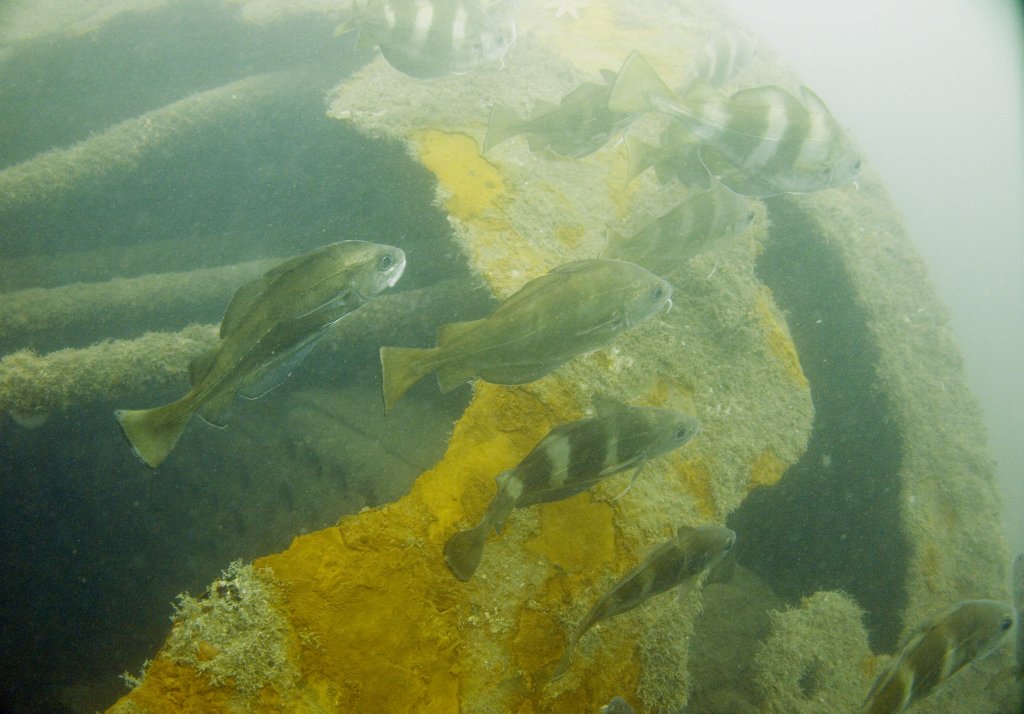
Huge shoals of Bib on Baygitano's boiler
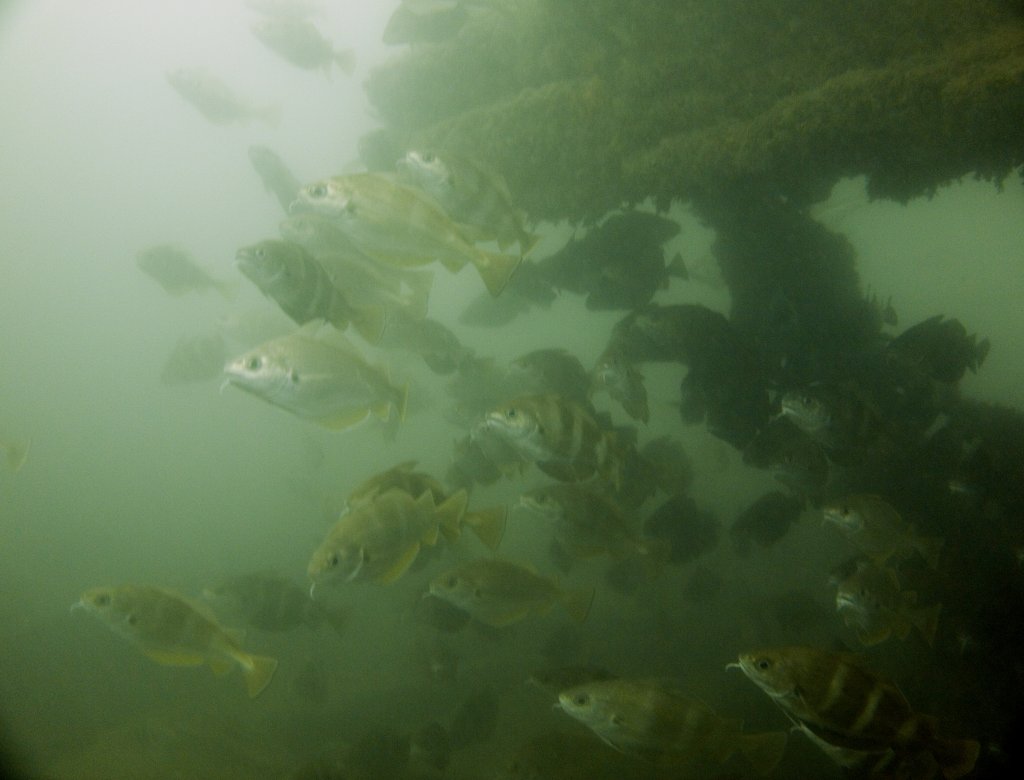
Huge shoals of Bib on Baygitano
On a previous dive one of our club was heard to grumble that "You couldn't see the wreck for the fish", but that's OK with me. It was also a chance to try out my new Canon G1X and housing and I got some fairly good shots for a first go.
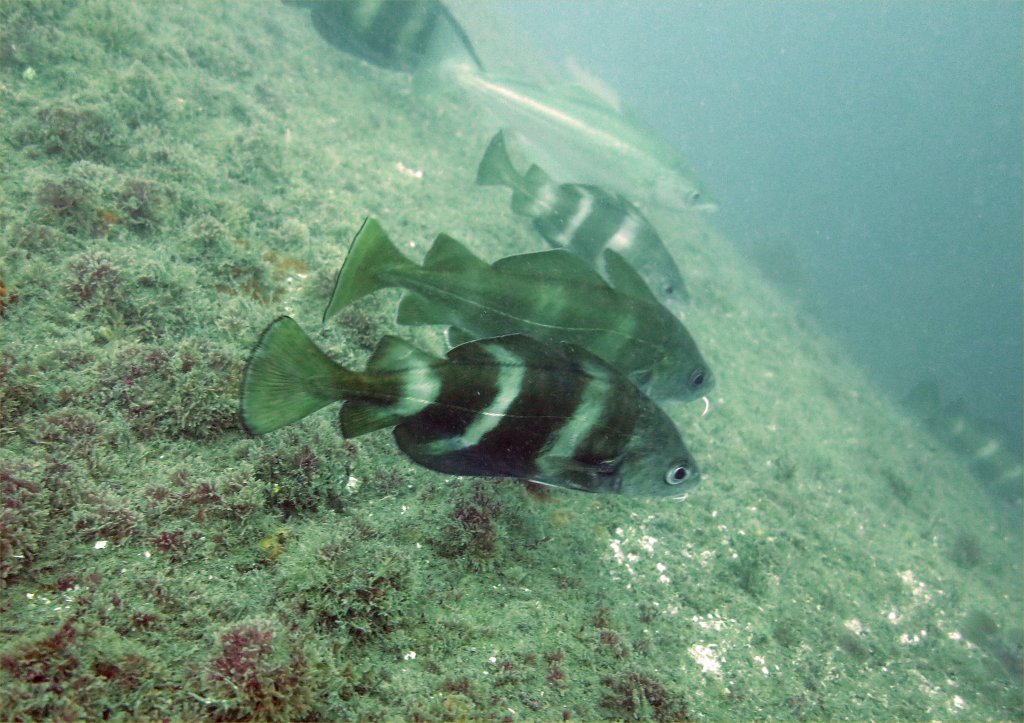
Bib and Pollock on Baygitano
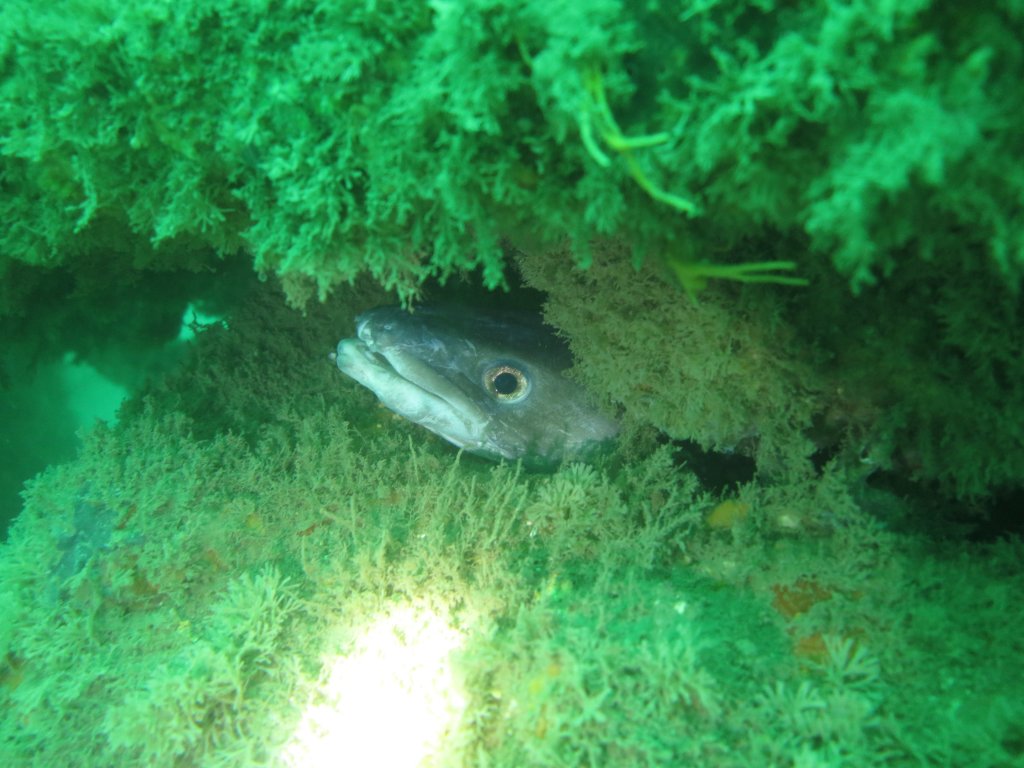
Conger on Baygitano
Dave and I dived together and dropped onto the boilers and then swam aft, finally finding the separated stern, after swimming along the mast. At that point we turned back and finally returned to the boilers and, just as I was about to give up the search, found the shot to ascend to the surface.
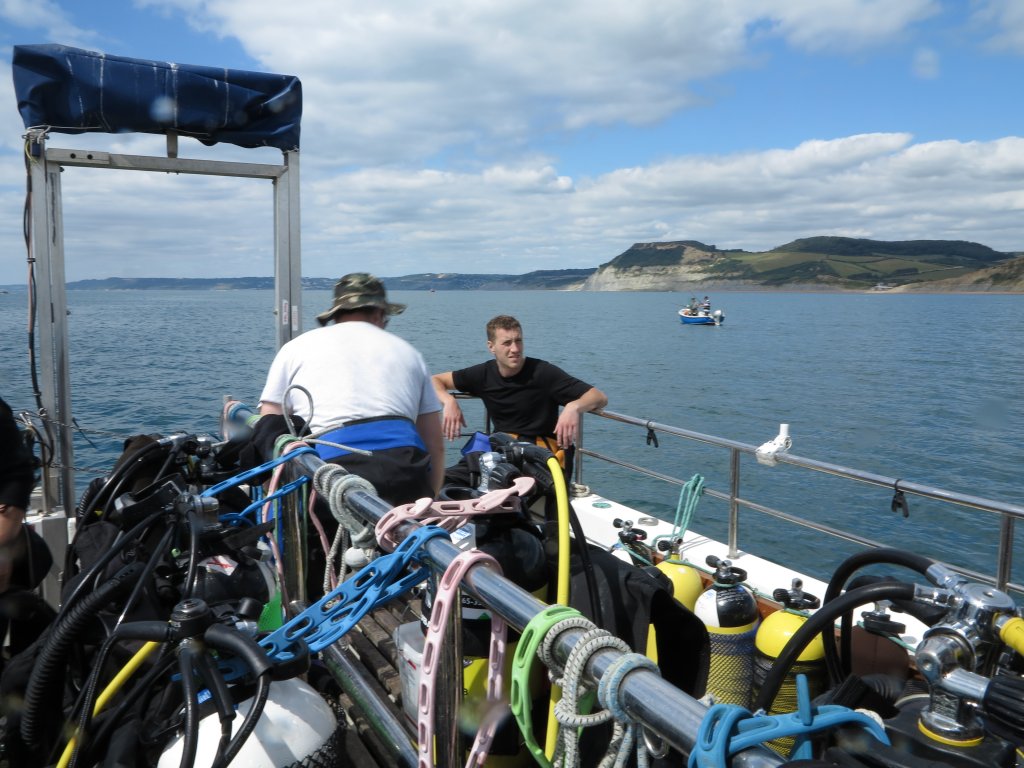
Kitting up for the afternoon dive
The afternoon dive was a gentle drift on a reef called 'High Ground'. It's a 1-2m high reef mostly covered in kelp and, although we saw a few fish and crabs in the kelp, we found most life along the wall where the reef meets the sandy sea bed.
Here we found plenty of Wrasse, blennies and crabs as well as some bigger fish (around a foot long).
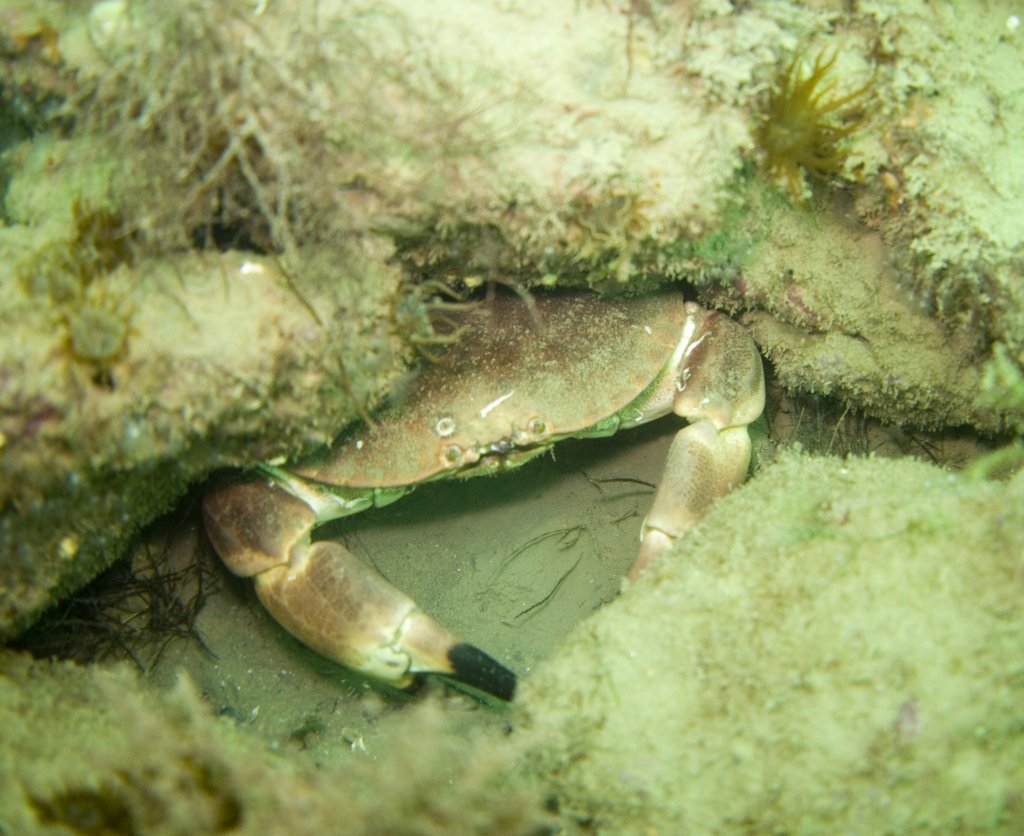
Crab on 'High Ground'
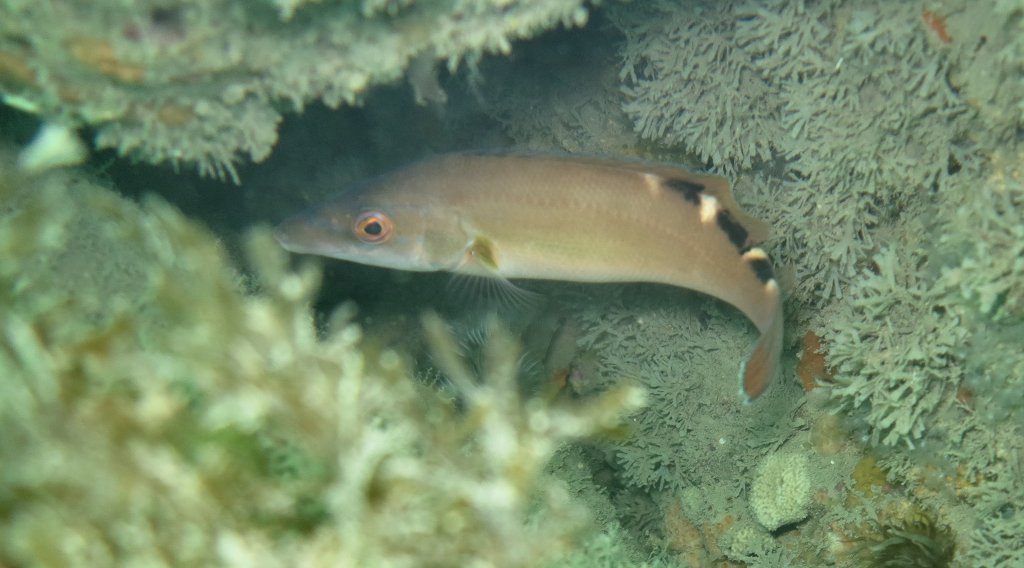
Cuckoo Wrasse on 'High Ground'
Overall we had a very enjoyable couple of days at West Bay, with good weather and some good diving (and plenty of life). It was a shame so few people took advantage of the charter as I fear it may mean even less hard boat diving for the club next year, which I prefer to Rib diving, personally.
Other commitments and the decision to have a bit of a break meant no more open water diving for a couple of weeks until our holiday in the Azores...
Read some more of my diving experiences, by clicking the icons below.


